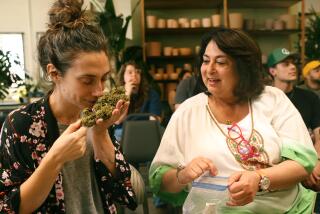Growing fennel for its flowers, seeds and potent pollen
Unlike many plants considered invasive, fennel does everything it can to ingratiate itself into the garden. Its leaves are attractive -- feathery and delicate -- and the umbrella-shaped blooms of bright yellow flowers that come in summer serve as miniature landing pads for pollinators. Every part of fennel, root to leaf to pollen to fruit, is infused with the varying levels of its iconic licorice flavor.
Unlike other aromatic crops -- dill, cumin, anise, caraway -- only fennel (Foeniculum vulgare) has become a transplanted Californian with such casual abandon. The South Mediterranean native was probably brought here by Italian immigrants and thrives throughout the state in the wild, on neglected land, anywhere there’s reliable moisture. Or not.
Jamie Jamison used to collect fennel flowers for their yellow hue, one of the natural dyes she makes. The flowers came from a healthy plant growing in a Smart & Final parking lot. She brought home another plant that spouted there randomly and now has a towering stand in her backyard.
A perennial if you let it, fennel spreads wildly, unabashedly earning its reputation as invasive.
“It’s a noxious weed, but it’s all usable,” says Gary Woolley, the general manager of Pollen Ranch, suppliers of fennel pollen, a gourmet flavoring with a powerful taste. A decade ago, a half-ounce of imported fennel pollen could run $40, four times what homegrown now sells for.
Based near Visalia, Pollen Ranch harvests the flower tops from wild fennel in Northern California in June and July, going back for the mature black seeds in October. Not only are they a different color than store-bought fennel seed, which mostly comes from Egypt, but the taste is far more intense.
A tiny amount of fennel pollen adds surprisingly sweet bright flashes of licorice to stews, sauces, soups and meat rubs. The rest of the plant is equally tasty. The bulbs can be eaten raw, broiled or pickled. The seeds are commonly used as an after-dinner digestive aid in Indian cuisine. The dead stalks are harvested for smoking, soaked like wood chips and added to a fire to impart an distinct anise-like note to fish or meat.
Fennel ranks high in Italian myth and history, as food and as medicine. When Prometheus stole fire from the gods to give to man, he held the coal in fennel. Roman soldiers chewed it for courage and to suppress appetites. In the Middle Ages, people hung it in homes for good luck and protection from the evil eye.
Now is the time to harvest pollen from a flowering plant, ideally in the afternoon. Leave cut flowers in the sun for a day, then put them in a paper bag until fully dry. Shake or rub off the pollen and collect it along with the dried flowers. Discard any stems.
You can find fennel at most nurseries in either seed or seedling form. The Florence varieties (Foeniculum vulgare var. azoricum) are grown in cool season for the fat bulbs. Because of its long taproot, the plant does not do well in containers, and don’t plant fennel near bush beans, peppers or tomatoes.
ALSO:
Growing the Italian green spigariello
The Global Garden is our series looking at multicultural L.A. through the lens of its landscapes. It appears here on Tuesdays.
JOIN US:
@latimeshome | pinterest.com/latimeshome | facebook.com/latimeshome | facebook.com/latimesgarden






